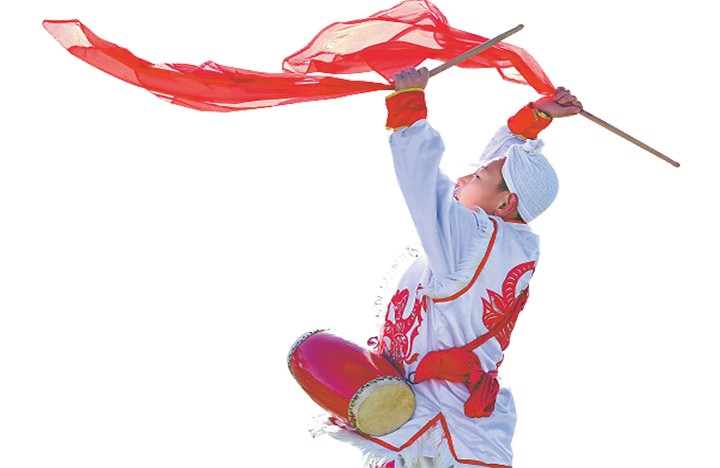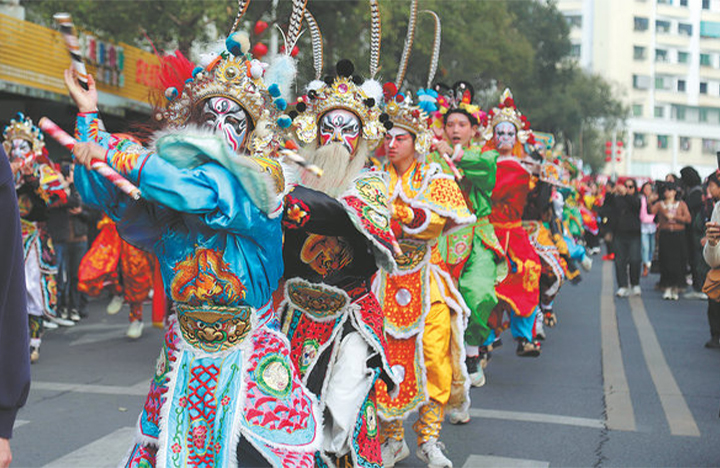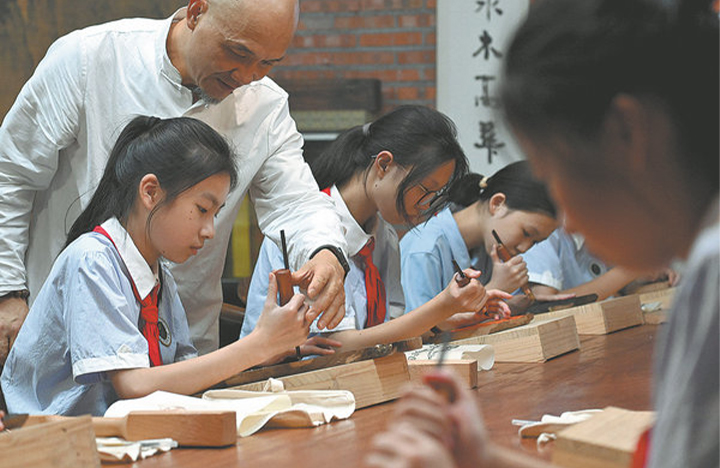



A primary school student from Ordos, Inner Mongolia autonomous region, performs Ansai waist drum at their school. [Photo/Xinhua]
In October, Bie Chuancheng left her job to begin visiting guardians of intangible cultural heritage and producing short videos featuring these artisans.
Bie, a member of the post-1995 generation, had worked at a fashion company in Shanghai.
Her ambitious goal is to visit 100 inheritors of such heritage to advocate for 100 Chinese intangible cultural heritage items and skills in her own way.
"I want to present the nation's cultural heritage in an engaging, trendy, practical and modern way. I want to bridge the gap between intangible cultural heritage and modern life from my perspective, enabling young people to experience the practical application of this heritage in their daily lives," she said.
The first inheritor she visited was Wang Rulan, a national-level inheritor specializing in crafting frameless lanterns in Taizhou, East China's Zhejiang province. In February, Wang took part in a China Central Television program highlighting traditional Chinese crafts.
In her video, which received more than 40,000 likes, Bie states: "The frameless lanterns are made entirely from mulberry paper without any supporting structure. A total of 72 procedures are required to produce a single piece of the paper, and tens of thousands of needles are used to complete a lantern."
Wang, 87, who has spent more than 60 years making these intricate lanterns, was recognized in 2018 as an inheritor of the fifth batch of national-level intangible cultural heritage.
Bie said: "Wang's dedication to this craft is unwavering. During holidays, she warmly welcomes anyone interested in visiting her home to see the lanterns. She has been incredibly supportive of my efforts. Making these lanterns is time-consuming, and she even prepares steamed sweet potatoes for me to eat and invites me to stay at her home."
Intangible cultural heritage artisans are always willing to share and spread their knowledge to young audiences, Bie said. More important, she said there is a growing interest among the younger generation in learning about such heritage through social media.
Within a few months, Bie's account on Xiaohongshu, the Chinese lifestyle platform, had attracted more than 40,000 followers and over 170,000 likes and saves.
"Over 90 percent of my followers are younger than 35. Many young people are genuinely interested in intangible cultural heritage, but previously, there were only a limited number of ways in which people could learn about this ancient craft," she said.
"Over the past year or two, there has been a surge in related content on social media, leading to a heightened awareness of traditional culture among young people."
The 2023 Intangible Cultural Heritage Data Report released by the Douyin short-video platform shows the platform aired an average of 19,000 livestream broadcasts on intangible cultural heritage every day, with an average of 13 new items per minute that included content related to this topic.
Furthermore, in 2021 and 2022, the total number of views of videos related to national-level intangible cultural heritage projects shown on the platform reached 372.6 billion.
The 2019 Digital New Youth Research Report indicated that nearly 90 percent of the young people surveyed expressed an interest in traditional culture.
When it comes to learning about traditional culture, 80.5 percent of young people rely on online media as their primary source of knowledge, the report said.
Gao Lu, a lecturer at Nanjing Normal University's School of Journalism and Communication, said social media platforms, especially those showing short videos, have become the main way in which young people obtain information about traditional culture.
Official data indicate that as of December 2022, the number of short-video users in China reached 1 billion. Gao added that new media technologies present traditional culture to young people in unprecedented ways, leading to increased interest and a deeper understanding of this subject.

A Yingge dance troupe from Shantou, Guangdong province, performs in the city on Feb 14. [Photo/Xinhua]
Interest triggered
Cao Lei, a 31-year-old white-collar worker from Nanchang, Jiangxi province, is testament to this trend.
Her interest in traditional Chinese culture was kindled after she watched short videos featuring Yingge Dance, a folk dance with a 300-year history from the Chaoshan region of Guangdong province.
This interest sparked Cao's quest to explore traditional cultures from different parts of the country.
"I initially delved into traditional culture out of curiosity. Over time, I sensed the festive atmosphere was fading during the Spring Festival. To understand how people in these areas celebrate Chinese New Year, I trawled online platforms to seek traditional customs that have been preserved, " she said.
After watching short videos extensively online, Cao became well-versed in the intricacies of Yingge Dance.
"It has a strong sense of tradition. Performers undergo rigorous training from a young age, and during Spring Festival, performance teams in every village dance to celebrate the occasion, creating a lively atmosphere," Cao said.
This year during the holiday, she began watching videos of Youshen, a Spring Festival custom from Southeast China, and quickly warmed to the talent of the young performers.
Youshen, which translates as "wandering gods", is a folk tradition from rural areas of Fujian province that dates to the Ming Dynasty (1368-1644). Villages hold joyous parades and other celebrations to welcome the start of spring, and pray to local gods and deities. Every year, they carry large sculptures of deities through streets and alleys to dispel evil, avert disaster, and seek blessings.
"I never thought traditional customs and performances could be so attractive and interesting," Cao said.
The online world has prompted young people such as Cao to explore traditional cultures and history.
"Last year, I visited an exhibition at Jiangxi Provincial Museum that showcased paintings of porcelain in Jiangxi alongside Dunhuang murals from Gansu province," Cao said.
Latest statistics released by the National Cultural Heritage Administration show that during Spring Festival this year (from Feb 10 to 17), museums nationwide received a total of 73.58 million visitors, a 98.6 percent year-on-year rise.
Su Qin, 34, a freelance guide at Liaoning Provincial Museum, said that in recent years, there has been a noticeable surge in the number of young visitors to the institution.
"The internet has played a significant role. The popularity of the summer destination of Zibo in Shandong province, the winter attractions of Harbin, Heilongjiang province, and the recent enthusiasm for cultural and historical relics are the combined result of young people's pursuit of China-chic (fancy designs mixed with elements of traditional culture), and promotion through social media," he said.
Su identified three main types of visitors to Liaoning Provincial Museum.
First, there are those who visit casually just to take photos and tick the venue off on their list. Second, some visit to attend specific exhibitions. The final group consists of visitors who, after browsing, develop an interest in history and culture before returning for a second or third visit, he said.
"It's not just the post-90s and post-00s generations who are flocking to museums, but even younger visitors. Many of the tour groups I've recently guided consist of young people who bring their children. Since the children need places to explore, museums and art galleries are the perfect solution. They are safe, the kids can learn, and admission is free," he added.
Rich history
Su believes the younger generation's love of traditional culture is not a random occurrence, but a natural result of their pursuit of a cultural life.
"After the 2008 Beijing Olympics, China's economy took a step forward, but cultural advancement temporarily lagged behind. Now that people have more money, they have started to turn their attention to cultural pursuits," he said.
Su added that young people are also attracted by the intrinsic and unique charm of Chinese culture.
"China boasts a long and rich history, with countless traditional cultural treasures waiting to be discovered by the younger generation, " he said.
Moreover, since the 2000s, the post-80s and post-90s age groups have gradually become the main force in society, with higher levels of education and greater cultural acceptance, Su said, adding that they also pursue novelty and individuality, so it's no surprise that young people are focusing on traditional culture.
He said institutions, including museums, have also launched cultural and creative products, attracting numerous young people to line up for purchases, and even scalpers selling refrigerator magnets.
"This situation could not have been imagined in the past. Museums are now also releasing short videos and conducting live broadcasts online," he said.
Social media platforms have become vital for museums to promote themselves. Douyin's 2023 Museum Data Report states that the total number of views of museum-related videos on the platform last year reached about 51.3 billion, 66 times the annual number of museum visitors nationwide.
Yuan Shuwu, an art theory researcher at the Central Academy of Fine Arts, attributes the recent rise in the popularity of traditional culture on social media to government promotion and extensive coverage by mainstream media.
"In the past few years, a series of documentaries and television programs have brought cultural relics and museums into public view, including Masters In Forbidden City in 2016 and The Nation's Greatest Treasures in 2017," Yuan said.
"Since then, there has been a gradual rise in the popularity of traditional culture. I have developed a strong interest in such culture, and after watching the two video series, decided to pursue graduate studies in art at the Central Academy of Fine Arts."

Wei Lizhong (second from left) instructs students at Hangzhou Guancheng Experimental School in engraving on Sept 28. [Photo/Xinhua]
Around the same time, Chinese food blogger Li Ziqi gained fame on YouTube for short videos she made that showcase her traditional and idyllic lifestyle in the Chinese countryside.
In turn, traditional culture has been revitalized due to the increased attention. Yuan said that in Fushan county, Linfen city, Shanxi province, where she now lives, intangible cultural heritage such as paper-cutting has benefited greatly from online dissemination through social media.
"Previously, little attention was paid to these cultural elements, but now it's different. There are many media reports, and inheritors of intangible cultural heritage now talk widely about their work. This has indirectly encouraged more young people to learn about and carry on these traditions," she said.
Kong Dejun, from Zhangxi town, Ganzhou city, Jiangxi, said he and his daughter are enthusiastic about inheriting and promoting their hometown's cultural folk art — the wooden-bench dragon dance.
"Our village has a bench dragon dance team, which includes many young people. I now live with my family in Guangdong, but whenever the village's dance team needs us, we return to take part in practice sessions and performances," he said.
During traditional holidays and summer vacations, Kong, 33, takes his daughter to Zhangxi to watch the performances and learn the dragon dance.
"Children who grow up in cities rarely see such lively and interesting things, so they really like the dance team and are eager to learn about the performances. This is probably the significance of inheritance," he said.
Gao, the lecturer, said young people's enthusiasm for traditional culture shows that historical and cultural confidence has been significantly enhanced in China.
She called for the further integration of intangible cultural heritage with digital new media.
"We should invite more inheritors of this heritage to the internet, to allow more young people to access high-quality cultural content and products through diverse technological means," Gao added.
Source: <https://www.chinadaily.com.cn/a/202403/18/WS65f76f3ea31082fc043bd14b.html>